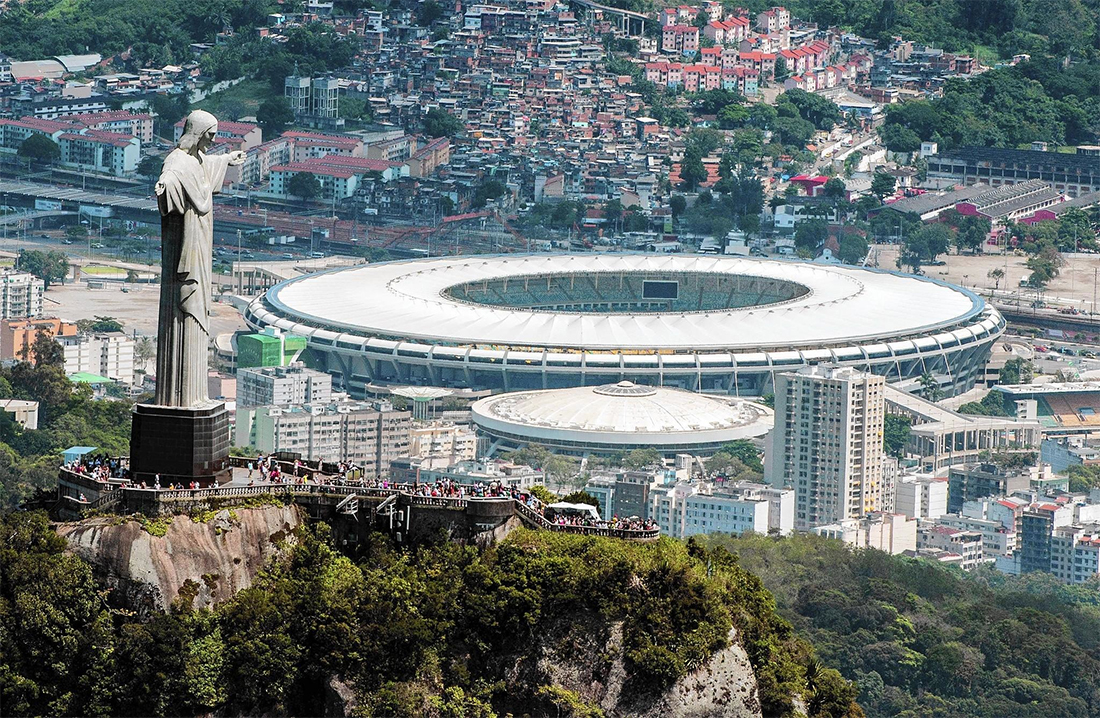Finn Hatherell | Staff Writer
With the 2014 World Cup only hours from its shrill first whistle this evening, it’s impossible to avoid the ever-increasing media and commercial attention these tournaments attract. Through the evolution of the internet and the deepening influence of social media, both football teams and players can now tap directly into a worldwide audience of billions. Not only is football the world’s most popular sport, but it is also the world’s only truly global sport. The FIFA app is now the number 1 sporting app in 116 countries, and what’s even more compelling is that this includes countries such as USA and New Zealand where one would expect other sports to dominate. As such, it is not simply the statue of Cristo Redentor that will cast an enormous shadow over this summer’s proceedings.
The World Cup’s commercial potential means that it is not only the footballers who will compete with one another.
Football players are now celebrities and worldwide icons in their own right. The media attention they receive is akin to that of Hollywood actors. Tune into Sky Sports News at any time of the day and you’ll see their presenters literally analysing what the English team eat for breakfast. In Uruguay, the media has been tracking every step of Luis Suarez daily routine for the last two weeks, agonising over whether he will be fit come Uruguay’s opening game. Brazil’s star player Neymar had a slight niggle in training which sent social media into a frenzy speculating whether or not he would miss the World Cup – a flurry of divisive and divided opinion over a sliver of what turned out to be truly inconsequential information.
The World Cup’s commercial potential means that it is not only the footballers who will compete with one another. The two biggest brands in sport, Nike and Adidas, have released their blockbuster, multi-million dollar ads pre-tournament. With Adidas releasing their cinematic ad ‘The Dream’ starring Messi and Suarez and Nike releasing ‘The Last Game’ starring the likes of Ronaldo and Rooney, both of these brands will blow through most of their marketing budget competing against each other in the run up to the World Cup. A common theme runs through both of their marketing campaigns. Adidas have based their world cup campaign around the tagline #AllInOrNothing with Nike opting for a similar one with #RiskEverything.
Adidas and Nike will both be hoping for an exciting World Cup in which their star athletes dazzle on the world’s biggest stage, with performance that conform as close as is humanly possible to their fantastical ad spots. The worldwide audience and media will also be hoping for a great tournament wherein the best players in the world showcase their talent in the spiritual home of football. However, despite the commercial and media hype and the expectations of fans worldwide, my fear is that this World Cup will fail to meet the expectations of either the fans or indeed the advertisers.
The 1982 World Cup was seen as a defeat for the beautiful game. In this tournament the attacking flair of Brazil was defeated by the more pragmatic and defensive style of the Italians. Many Brazilians feel that the national team has never fully returned to that free-flowing philosophy, as a more disciplined approach had taken precedence. The sheer lack of samba style and attacking guile is most striking in the current Brazil national team, which even the great Pele concedes, that ‘for the first time ever Brazil’s defence is better than their attack’.
The Champions League final was a dour affair, but an accurate reflection of the current state of football.
The language in phrases such as #allinornothing and #riskeverything speaks to how every fan wants to see football played with teams setting out to attack and outscore their opponent. Unfortunately these tag-lines do not in any way represent the current state of international football. Nike’s commercial ‘The Last Game’ tells the story of the world’s best players being replaced by robots until the Nike players find their guile and flare again to eventually defeat the cynical footballing cyborgs. The sad irony of this commercial is that the Nike robots are a more accurate portrayal of the style in which this World Cup will be played out in comparison to the nike superstars.

In this years piéce de resistance of club football – the Champions League final, we saw eleven robotically rigid Atletico Madrid players hold out a clueless Real Madrid team for 90 minutes. Supposedly the best players in the world, the supposed flair of Ronaldo and Bale were nowhere to be seen for 90 minutes and only had an impact after 110 minutes when the Atletico players were struggling to stay upright. The Champions League final was a dour affair, but an accurate reflection of the current state of football.
The way in which the last two world cups have played out does not make for good viewing either. The 2006 tournament was one by a defensively minded Italian team whose best player was their centre back, Fabio Cannavaro. The 2010 tournament was a truly dismal affair with the evolution and increasing significance of a team’s ‘defensive midfielder’. In this World Cup we saw all of Argentina’s attacking panache compromised by its defensively minded coach, none other than Diego Maradona, who kept the likes of Aguero, Di Maria and Higuain on the bench. Most teams defended with eleven men and played with two defensive midfielders which sadly enough actually proved to be quite successful. This is most succinctly summed up by the success of The Netherlands in South Africa. In reaching the final they abandoned all of their Cruyffian traditions and virtues of ‘Total Football’ in favour of defensive discipline and grit. Even Spain, who won the tournament, and won many plaudits for their ‘tiki-taka’ style of football, played with three deep-lying midfield players: Busquets, Xavi and Alonso.
This World Cup will not be won by exciting football and flair players but by astute tacticians and defensive disciplinarians.
My fear is that this is a contagion that will contaminate this world cup. The world will look to the likes of Messi, Suarez and Neymar to light up this tournament even though each of them will be man marked within every blade of grass they cover. Teams no longer focus on their own strengths but on those of their opponents, and as such we may see teams formulate their entire game plan around how to stop the special players. Furthermore, wonderful midfield attacking talents like Eden Hazard, Raheem Sterling and Angel Di Maria may be compromised by their midfield defensive duties, wasting their energy tracking back to help out their defences as opposed to running at opponents.
This World Cup will not be won by exciting football and flair players but by astute tacticians and defensive disciplinarians. Perhaps I will be proven wrong but I think that Adidas and Nike may have to rephrase their future marketing campaigns. Maybe the more pragmatic, standard-black Puma King should be the official boot supplier, or the old-fashioned, generic Umbro the tournament’s kit supplier. Let’s hope, instead, that Adidas and Nike’s advertisements have set a trend for this World Cup and we’ll see teams go #AllInOrNothing, ]see players #RiskEverything. If not, their marketing departments may have to meet the more challenging demand of devising a blockbuster ad that conforms to the more realistic slogan of #PlaySafeWinUgly.







